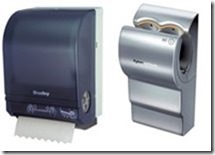
Going green with hand dryers can reduce carbon dioxide emissions, reduce landfill waste and can save facility managers up to 98% versus paper towel costs.
While paper towels generally have low up-front costs to install the paper towel dispensers, the operational costs can really add up, including ongoing refills, frequent replacement of plastic trash can liners, more cleaning chemicals and increased janitorial labor to keep pace with the restroom’s typically messy consumers.
Hand dryers represent a larger up-front investment, but have lower ongoing operational costs and can be the more sanitary choice. Cutting-edge technology in hand dryers such as the Xlerator, ExtremeAir, and Dyson Airblade (just to name a few) offer far superior cost savings and energy savings (some are as low as 540 watts compared to older 2,200 watt versions). Hand dryers like Dyson’s Air Knife strip liquids from solids and uses HEPA air filters to eliminate 99.9% of bacteria.
Scientists at Massachusetts Institute of Technology completed a major study in 2011 assessing the greenest way of drying your hands. The study looked at the entire life cycle of various competing products – materials, manufacturing, transportation, operation and end of life. While paper towels, particularly those from recycled materials, are often seen by consumers as the greener choice, the study found that hand dryers were by far the greener choice. Paper towels alone contribute annually to 2% of total landfill waste and are generate more than 3x more carbon emissions that current hand dryer technology, like the Dyson Airblade.
While some customers may still prefer old-fashioned paper towels, science has spoken. Hand dryers are the greener – and more economical—choice.
































